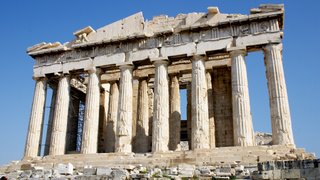The Parthenon. Athens, Greece. Marble, 447-432 BC.

Well holy crap, it looks like my blog has a reader! I've been busy with things, so I'd pretty much pushed this thing to the bottom of my to-do list, but I can't disappoint my one fan! So thanks to Dungan, my one reader! Woohoo!
So once upon a time I said I'd tell you about the Acropolis, and here it comes, starting with its highlight, the Parthenon. Now people often confuse the Parthenon with its Roman cousin, the Pantheon. Buf if you confuse these two in front of any art historian, they will think you are stupid. (We art historians are a pretty critical bunch.) So today it's the Parthenon, and once I'm done with the Acropolis, we'll look at the Pantheon.
But back to the task at hand. As you may recall, Dungan, the Delian League had just won a war against Persia. As the head of the Delian League, Athens saw some extra war funds lying around and decided the money would be well used by building a big, pretty temple. Okay, so there were a few good reasons for building it. One, Athens was to be the new site of the Delian League's treasury, so a structure was needed to hold all of the loot. Two, having just won the war, Athens thought it would be nice to build a temple to Athena to thank her for her help. The temple was dedicated to Athena the virgin, or Athena Parthenos in ancient Greek, hence the name Parthenon.
Building on the Parthenon began in 447 BC. The entire project was overseen by the famous sculptor Pheidias, while the chief architects were Iktinos and Kallikrates. The temple is made almost exclusively out of Pentelic marble, a flawless white marble with a faint yellow tint that comes from Mount Pentelicon, about ten miles northeast of Athens. Transporting the marble to Athens was actually the biggest expense on the project. According to Ancient-Greece.org, the Parthenon in total cost 469 silver talents. That may not sound like much, but one talent could buy you a trireme, or pay an entire ship's crew for a whole month. Sure, Athens could have been building triremes and things in case the Persians attacked again, but where's the fun in that?
In its original splendor, the Parthenon was really someting, architecturally and sculpturally. Architecturally it's known for its entasis. That's your vocab word of the day, kids, better write it down. It's pronounced in-tas-is. Like if you said "in", then "task" without the k, and then "brisk" without the br and the k. Intaskbrisk. Man, I shoulda been an English teacher. But back to entasis. Entasis is basically an architectural trick in which you build something with curves instead of straight lines, so that when you're looking at it, it looks more straight. Man, that's a horrible definition. Okay, I'm stealing this definition from Wiki:
In architecture, entasis is a design technique used to counteract a certain optical illusion. When a column or other structure is designed with parallel sides, the sides appear to have a slight inward curve. Entasis is the inclusion of a slight outward curve in the sides - making them not parallel - to counteract this optical effect. The goal, somewhat paradoxically, is to give the appearance of straight lines through the use of curves and optical illusion.Now there's a definition that makes sense. So, the Parthenon may look nice and straight, but the columns are slightly cigar-shaped, the main platform of the temple curves upward, the columns all lean inward, and the columns at the four corners are thicker than the rest. I have no desire to get into optics here, but all of these things were done with the intention of making the temple look perfect.
Sculpturally, there's a lot to look at, and I'm running out of space, so over the next few days we'll look at the pediments, metopes, Panathenaic Procession, and statue of Athena.
But one final word on the Parthenon itself: It's been pretty badly abused over the last few thousand years, primarily by the two most destructive forces on earth: wars and churches. In the 6th century, the Partheonon was converted into a Christian church, and a lot of decoration that was considered "pagan" was destroyed. Then in 1456 the Parthenon was converted into a mosque, and for a while had its own minaret. About 200 years later, in a war between the Turks and the Venetians, a bomb destroyed what was left of the roof and most of the remaining internal structures. This is what happens when you use the Partheonon as a powder magazine. Let that be a lesson to all of you.



